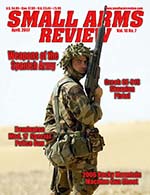By Lawrence Heiskell
One afternoon last Fall I received a call from the range master at my police department with some bad news. The M50 Reising submachine gun that I had admired for the past 14 years was to be destroyed.
The police department had undergone an exhaustive in-house search for any existing registration paperwork on the gun but nothing could be found. It was then determined by the police department administration that the gun was contraband and was marked for destruction.
Several days later, I decided to take action to try and save this historic departmentalweapon. Having been a reserve police officer at the police department for the past 14 years, I knew several ATF agents that I had worked with over the years. I placed a call to ATF Los Angeles Field Division’s Senior Special Agent Paul Hagerty and began to inquire as to what options the police department had in an attempt to try and save this gun; such as donate it to a museum.
Registering it on a Form 10 was an option that would save it from destruction but it would eliminate the gun from ever being transferred to an individual. I just could not believe that this machine gun was not registered at some time in the past and that the NFA Branch might by some chance have some documentation.
I gave Special Agent Hagerty the serial number and he told me to give him a couple of days and that he would contact the NFA Branch and see if any information could be found.
Two days later I received a call from Special Hagerty with great news. The ATF/NFA Branch had found the original paperwork and a copy of the transfer from Federal Laboratories of Philadelphia, Pennsylvania. The M50 Reising had been legally registered and transferred to the City of Palm Springs Police Department on April 7, 1949. The NFA branch examiner then faxed a copy of the following to the Police Department: the paperwork and a letter stating that the M50 Reising submachine gun was unrestricted and could be transferred to an individual.
After discussions and negotiations with the City of Palm Springs and my police department, the decision was made not to destroy the weapon but to transfer the Reising to my father in Virginia on his FFL on a Form 4. The necessary transfer paperwork was completed in less than 45 days and the gun left its home of 57 years in California for its new home in Virginia.
This M50 Reising is a rare late 2nd design transition gun. It has the military 14- fin barrel and reinforced rear sight in a walnut stock with sling swivels. It also has the reinforcing pins in the stock, the larger knurled take down screw, milled three screw trigger guard and, instead of being parkerized, has a beautiful polished blued finish.
The data inscription Model 50 - H & R Reising - Cal 45 Harrington & Richardson Arms Co. reads from lef to right on the top of the receiver. The compensator has the adjustable front sight and the bore is mint. The magazine well accepts both the 20 and the 12-round magazines and has the pushtype magazine release lever.
The Reising M50 submachine gun was used by many police and sheriffs departments during WWII and was used by law enforcement agencies well in the 1950’s. Despite the reports that it failed on the sandy beaches with the USMC, if it is keep clean it will functional beautifully. They are very accurate out to 200 yards on single fire since they fire from a closed bolt system and fire the popular .45 ACP cartridge.
The Reising does not deserve the bad press it has received over the years. Numerous police and sheriffs departments purchased the Reising in very large quantities and many prisons used them for arming the guards. Besides seeing action in the Pacific during World War II, on the home front, it was used to guard factories, plants, railroads and bridges. All vital to the Arsenal of Democracy during the Second World War.
Fortunately, this historic gun was rescued from a fate of destruction. Just because paperwork can’t be located doesn’t mean that the gun wasn’t properly registered at some point in its past, as was the case concerning this M50 Reising. With a little perseverance and luck, other “questionably registered” historic guns can, and should be, saved.
This article first appeared in Small Arms Review V10N7 (April 2007) |
| SUBSCRIBER COMMENT AREA |
Comments have not been generated for this article.





